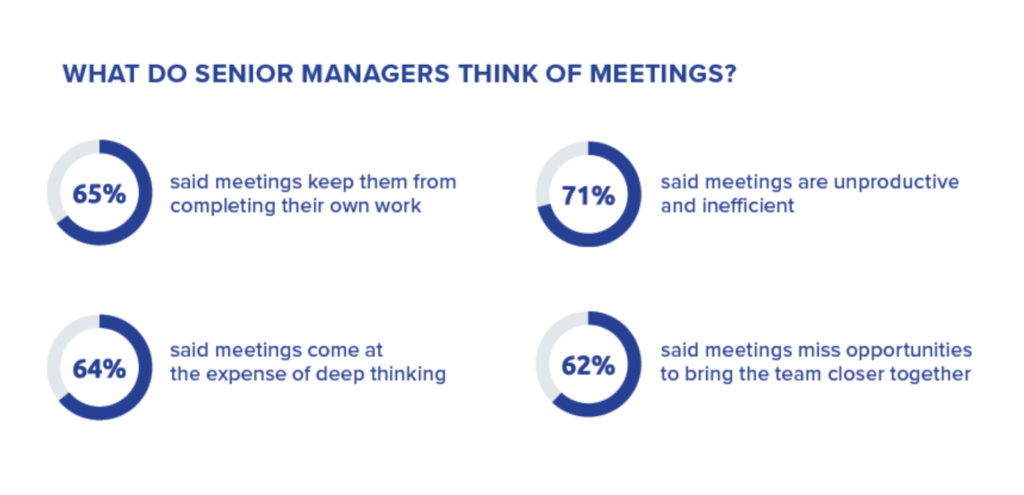Over the past 50 years, we’ve spent more and more of our working week sitting in meetings, but there doesn’t seem to be a payoff. In fact, it’s the opposite.
Consider this 2017 Harvard Business Review study: Of 182 senior managers surveyed, 65% said meetings kept them from completing their work, and 71% said meetings are unproductive. One of the respondents admitted jabbing herself in the leg with a pencil “to stop herself from screaming during a particularly tortuous staff meeting.”

But meetings don’t have to be a form of emotional torture. In many innovative organizations, they’re the opposite.
If you’re careful and use them sparingly, meetings can take a sledgehammer to the status quo and clear the way for a new type of work. To see how, we profiled five innovative meetings that are revolutionizing the modern workplace.
The daily huddle
Every morning, in offices all across San Francisco, teams meet around desks for a quick 15-minute meeting. During their short meeting, they answer three simple questions: What are your priorities over the next 24 hours? What are your daily metrics? And where are you stuck?
The appeal of the “daily huddle,” as it’s called, is quite clear: “The daily huddle tracks progress and brings out sticking points that are blocking your execution,” entrepreneur and consultant Verne Harnish explained on the Growth Institute. Since daily huddles crept into Silicon Valley decades ago, they’ve become a core part of the workday—up there with getting your morning coffee.
But recently, they’ve begun spreading out into new industries and sectors. Robert Moses, founder of corporate career media company, The Corporate Connoisseur, recently rolled our daily huddles to his team to stay on top of his company’s growing output. “The [daily huddle] occurs first thing in the morning and is meant to lay out a path of what work has been completed and what is still in progress,” Moses tells RingCentral.
“For any item still in progress, we will rate its priority and assign additional staff members to assist with its completion. The daily stand-ups have definitely helped us approach our workload in a more efficient manner.”
Chance encounters
In the early 1950s, MIT campus planners were looking for more space. Instead of building new offices, they slapped a new coat of paint on Building 20, a makeshift structure they’d built during the Second World War to house radar research. It was a bit ramshackle and messy but it was good enough for academics. Little did they know that Building 20’s slapdash design would eventually revolutionize communication.
When MIT’s academics moved in, the college let them do whatever they wanted with the space. Walls, doors, and partitions appeared and disappeared in the blink of an eye, creating a constantly changing (and very confusing) floor plan.
Even people who’d been there from the start got lost searching for offices, doors, and staircases that suddenly didn’t exist. And that’s where the key to communication lay. Moving anywhere in the building meant academics were walking past their colleagues, creating loads of knowledge spillover opportunities—opportunities for ideas and information to pass between people and disciplines.
With ideas flowing freely, creativity and collaboration were both super common. Over the course of its 20-year lifespan, nine Nobel Prize winners worked within Building 20.
Building 20 gave us a template for great communication and replicating is pretty easy—but only if you have a physical space to work with. But with remote teams, you don’t have walls and corridors and offices and rec rooms. People work wherever they want on their own schedule.
But at Buffer, Co-Founders Joel Gascoigne and Leo Widrich found a way around that challenge. In late-2014, Buffer rolled out a program designed to create knowledge spillover opportunities. “Each teammate was paired with another based on tenure and role,” recalled Nicole Miller, Buffer’s community champion. During their calls, teammates discussed their achievements, challenges, and life outside of work.
Each call created a chance encounter like those in Building 20. And bit by bit, knowledge has seeped out of Buffer’s siloed teams, creating a more connected, creative, and collaborative organization.
There are tons of ways to use video meetings.
Join us and learn about them in this webinar.
Watch now
Flipped learning
In the early 2010s, a group of teachers began thinking about homework—or more precisely, how it was broken. Most schools were set up in the same way: teachers taught in the classroom and students practiced that knowledge at home. That was how classrooms worked for hundreds of years. But these teachers reckoned it might not be the best way.
They wondered if it was inefficient to spend all their time standing in front of the class delivering a one-size-fits-all lesson to their students. Maybe it would be better to have kids watch a recording of the lesson at home and use their teaching time to help individual students process and consolidate that knowledge.
The movement was called “flipped learning” and it was extremely effective—and not just in schools. Many businesses have tested out the new method, abandoning in-office training sessions. Instead, trainees work through various learning materials at home. When they arrive at work, they’re ready to consolidate their knowledge and learn how to use it. During these in-office meetings, trainers help trainees with sticking points and practice putting their knowledge to the test.
At Play with a Purpose, an experiential meeting consultancy, CEO Sharon Fisher uses flipped learning to maximize the impact of meetings. “I did a new product launch for a medical-device business, and they didn’t want to get to the meeting and spend the whole time downloading texts about the device,” she explained. “So when we got together, we had hour-long sessions for the tech piece, the selling piece, and the strategy piece.”
Wins, wins, wins
Every Friday afternoon, the entire Percolate team meets around the office kitchen table. But employees at the content marketing platform aren’t there to discuss new projects. They’re there to throw out high fives and fistbumps and celebrate their wins from the past week. “The idea behind this gathering is to acknowledge the great work happening around the company,” Percolate’s former marketing product manager Jason Shen wrote in 2014
During the weekly win meeting, everyone shares a few achievements from the week—a new version of their app launching, a customer signing a new deal, or getting some great customer feedback. Anecdotally, Shen suggests bookending the week with weekly wins meetings helps bring work to a close and help employees relax.
But the real value of a wins meeting goes much deeper. A study from Harvard Business Review looked into the mental impact of small wins on members of project teams. It found that wins, even if they’re small, have a huge impact on how we feel.
“[E]ven small wins can boost inner work life tremendously,” wrote the study’s authors. “Many of the progress events our research participants reported represented only minor steps forward. Yet they often evoked outsize positive reactions.”
The study contains an interesting diary entry from a programmer at a technology company. During the week, she had struggled to get a particular product working. But eventually she cracked the code, and we can see from her diary what a positive impact that had. “I figured out why something was not working correctly,” she wrote. “I felt relieved and happy because this was a minor milestone for me.”
Always-on video calls
What do you think the worst part of remote work is? Finding good Wi-Fi? Nope. Pumping yourself up for work? Wrong again. What about resisting the urge to do the dishes or laundry? Not quite.
The answer is loneliness. (Okay, technically it’s second after unplugging after work, but it’s still super important.)
When you think about it, it’s easy to see why remote workers are so lonely. They wake up, jump on a quick morning huddle, and then work on their own for the next eight hours. Even for the most introverted people, that’s a lot of alone time.
One way to fight back against loneliness is by recreating the office environment through permanent, always-on video meetings—something Connor McMorrow experimented with at Linc Global.
When McMorrow joined Linc as an industry solutions architect at a software company, he found himself working across a number of different departments, such as sales, customer success, and product. While each team faced different challenges, he quickly spotted an important trend—remote workers felt detached and isolated from the wider company. To re-engage employees, he knew he would have to get creative.
One solution McMorrow tested was a virtual meeting room for remote employees. “It works just like it sounds,” McMorrow tells RingCentral. “One teammate queues up a video call, invites all members, and everyone joins.”
The key difference between meetings like this and normal video calls? McMorrow’s attendees weren’t working together. They were just hanging out in a call and getting on with their own work. In between tasks, conversations broke out, just like they would in a physical office environment.
McMorrow says that their communal call helped build camaraderie between remote coworkers, who were used to working on their own. “It helped a lot with productivity,” he says. “Our remote team was able to get quicker responses to their questions and, since we had an open forum framework, it inspired a lot of group discussions, allowing team members to join in on relevant discussions.”



